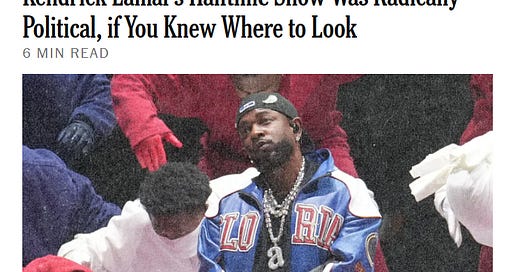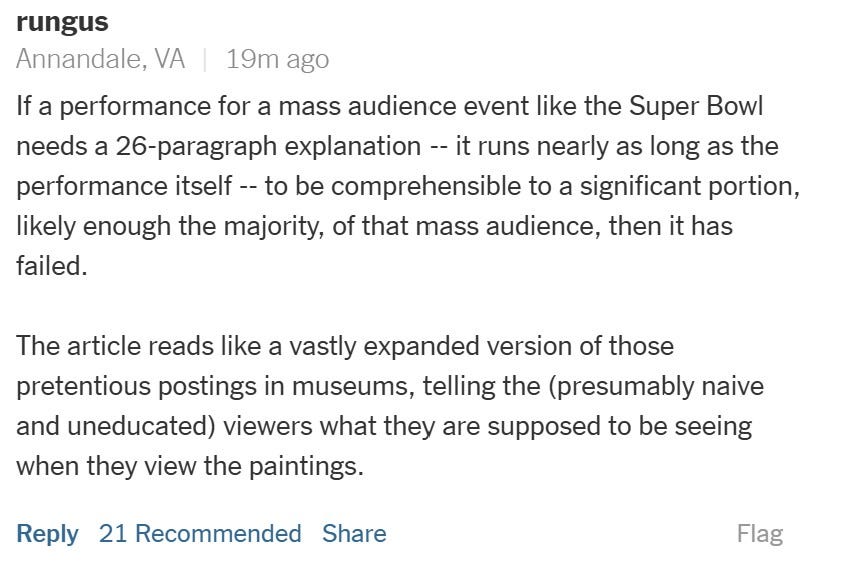I’ve long become used to the Liberal bias in most mainstream outlets such as The New York Times. Each day it seems packed with more and more TDS editorials, DEI Op-Eds, and frivolous sections designed to appeal more to an upstate mental asylum than the constant reader.
Even with all of this, I still thought of it as a good source of news as long as you had an understanding of the inherent left-wing tilt in the style of reporting. Although lately, I’m beginning to seriously doubt this assumption after seeing the NYT latest offering from a guest piece regarding the Super Bowl halftime show.
The Super Bowl holds a valued place in the American cultural zeitgeist well over half a century now, with a tradition of folks gathering for watch parties even if their favorite team did not make the main event. Due to the exorbitant costs and guaranteed audience, tuning in for the commercials alone has been a yearly staple. At $8 million for a 30-second spot during the game, the creativity seen from the best NY adhouses was usually worth it. Others watch the Super Bowl for the lively halftime show that features a popular music artist.
But it was this year’s halftime show featuring rapper Kendrick Lamar that confused many for its incoherence and mumbled presentation. A guest essay from poet and scholar(?) Tiana Clark bravely explains what us simple plebes missed from this performance. Here are some selections from the article:
More viewers tuned into watch Kendrick Lamar — 133.5 million people — than any other Super Bowl halftime show. And they witnessed a rousing concert by a 22-time Grammy-winning (as well as one Pulitzer-winning) artist. But there was much more on display, if you knew where to look for it.
Welcome to 2025 Ms. Clark. The advent of streaming services and connectivity pretty much insures a captive audience during an event such as the Super Bowl. Pointing out viewership numbers as a gauge of approval is not a good marker.
Mr. Lamar provided a layered spectacle of cultural and political allusions, encoded in and percolating through propulsive rap, 13 minutes of profound protest art that compelled me to shout gleefully at my TV in response to the audacity I was witnessing. With the multifaceted symbolism unspooling before me, I felt compelled to break down the brilliant complexities.
Ms. Clark then proceeds to break down Mr. Lamar’s 13 minutes with a 26 paragraph essay. Even some regular New York Times commenters found this pontificating over a DEI rapper show excessive and silly.
Mr. Lamar doubled down on the gamification theme when he rapped: “Forty acres and a mule, this is bigger than the music. Yeah, they tried to rig the game, but you can’t fake influence.” He was doing nuanced work: talking, yes, about his beef with Drake, which led to his hit song “Not Like Us,” but also extending the metaphor to indict America and white hegemonic power.
By citing “40 acres,” Mr. Lamar was alluding to Field Order No. 15, a promise to allocate some 400,000 acres of land once owned by Confederates to former Black slaves. The promise was broken when Andrew Johnson, Lincoln’s successor, overturned the order in 1865.
Reparations whispering. Subtle.
Then Samuel L. Jackson appeared dressed as patriotism personified: the military recruitment propaganda character of Uncle Sam, shouting like a carnival barker, “This is the great American game!”
Honestly, the only words I understood from the entire halftime show were from Samuel L. Jackson.
Throughout the satirical performance, Mr. Jackson voiced critiques of Mr. Lamar, sounding like a different uncle: Uncle Tom of “Uncle Tom’s Cabin,” striving to placate, subdue and dilute Mr. Lamar’s message. At one point Mr. Jackson reprimanded Mr. Lamar, declaring his performance “too loud, too reckless, too ghetto.”
For me, this was a harsh reminder of several injustices — like the gruesome murder of Jordan Davis, 17, on Nov. 23, 2012. Jordan was gunned down by a 45-year-old white man, Michael Dunn, at a gas station in Jacksonville, Fla., after playing what Mr. Dunn called his “rap crap” too loud.
It also recalled Sandra Bland, who refused to put her phone away during a 2015 traffic stop, stating that she had a right to record the interaction. A dispute erupted between her and a state trooper, who drew his stun gun and shouted, “I will light you up. Get out. Now.” Ms. Bland was forced to the ground and arrested.
The Texas Department of Public Safety stated that she “became argumentative and uncooperative” during the arrest — too loud, too reckless.
Three days later, Ms. Bland was found dead in her jail cell.
In a nation of 350 million it is easy to conjure up multiple examples like this. The country is huge. The real trick is that you can never mention an injustice that doesn’t involve the approved who/whom of victim and aggressor. Ms. Clark does an excellent summation of Motte and Bailey here as if reasonable people will argue that these events were fine and dandy to occur. I’ll give her style points from refraining from mentioning Emmett Till at least. NYT must have already filled their quota of ET this month.
We know that Mr. Jackson knows what Mr. Lamar knows: We at home are not just passive spectators. Mr. Lamar is speaking directly to us, but in code. “Not Like Us” is not just about Drake anymore. It’s a diss track to America, an audacious indictment delivered as a rallying anthem designed to unite us and revive our weary, burned-out reserves.
The Super Bowl halftime show has always been the perfect venue to drop diss tracks on America.
Tradition really.
Surprising that there weren’t more accolades for such a brave moment.
This perfectly set up perhaps the most resonant image of the halftime show: a living American flag as embodied by Black dancers in red, white and blue, a reminder of the backs that built this country against their will, with Mr. Lamar situated in the center. Reframing the threat of a Black man in a hoodie through powerful iconography, portraying what freedom can look like, instead of what we usually see on our TV screens: dead or broken Black bodies, exploited as pejorative tropes. This was American symbolism through the lens of bold and unapologetic Blackness.
This vision of America as a sort of dystopian race wasteland where folks are dying by the thousands (millions) due to racial strife and horrors is a trope at this point. “What we usually see” is exactly what mainstream media presents to us as a version of reality.
Kendrick Lamar is the ultimate trickster in his Celine boot-cut jeans, outwitting the problematic American game by employing the lexicon of the rap beef repartee, weaving his coded messages for the intended audience that needed these camouflaged ciphers the most. He is like Harriet Tubman mimicking the hoot of the barred owl as a conductor on the Underground Railroad, guiding freedom seekers away from detection and danger.
I have no idea what this means.
But nothing could top the way I shouted at the significance of seeing Serena Williams “Crip walking” during Mr. Lamar’s “Not Like Us,” reclaiming Black joy. Not only did it celebrate Compton, the Los Angeles County city where Ms. Williams grew up, but it reclaimed the joy that was weaponized against her after she celebrated her 2012 London Olympics gold medal with a three-second Crip walk, unleashing an onslaught of racist commentary and a Fox News headline, “Serena Flubs Crowning Moment.”
Why must the ways we celebrate our victories be mocked and condemned? Why must our successes accommodate the comfort zone of people who do not value or recognize our humanity? Why must our resilient joy be caged? Ms. Williams answered each of these questions through a Black dance with gorgeous confidence, taking back what should have been her glorious moment 13 years ago.
Sidewalk dancing to urban street gang jingles is empowering. Black Joy or something. Quite audacious of Ms. Clark to speak of humanity in relation to a 50+ year criminal group responsible for thousands of deaths.
After watching this 13-minute performance, I realized that, although I might not be able to stop the current onslaught of dispiriting news, I do have agency. I can turn off the TV — which was Mr. Lamar’s last command to the viewers, using his hand to mime a remote facing us. The action echoed his declaration at the start of his performance, as he knelt on top of a Buick GNX: “The revolution ’bout to be televised. You picked the right time, but the wrong guy.”
This mutinous slogan responded to and was an inversion of Gil Scott-Heron’s 1971 song “The Revolution Will Not Be Televised,” which, according to his biographer Marcus Baram, Mr. Scott-Heron wrote in part to highlight “the disconnect between the consumerism celebrated on TV with the protests happening on the streets of America.” Mr. Lamar flipped the meaning of these famous words during this radical televised performance — ending with a wake-up call meant to remind us that we do, indeed, have control, and the controller, in our hands. We have the tools for resistance and revolution at our disposal.
All this talk of resistance and revolution rings hollow at this point. BLM, for all intent and purpose has, well, no more purpose. They’ve already bought enough nice homes in White neighborhoods. The money spent on riots and who knows what else is long gone down the rabbit hole. Corporations are not bending the knee and giving fealty to this like we saw after the ‘Summer of Floyd. Calls for the release of Derek Chauvin become louder everyday as more folks see the actual injustice of locking up the police officer due to the mass hysteria and witch hunt atmosphere at the time. Revolution without direction or meaning is all this is.
I turned off my TV, staring at the black void of the screen, buzzing from what I’d just witnessed. Texts spilled in from friends with a slew of exclamation points, all of us in awe, inspired and lit up. I played Mr. Lamar’s song “squabble up” and started dancing in my living room by myself, the first time I’ve let myself feel uninhibited and reassured in 2025. I didn’t realize how much I had been clutching my breath. My unyielding body — a tight fist since the inauguration.
Actually surprised it took this long to reference the presidential election. Impressed that she had a smidgen of willpower to hold out this long.
There were, of course, dozens of other references, echoes and allusions in the show. If you didn’t catch or understand all of them, that’s OK. For those of us who did, we got the message, Kendrick Lamar. We heard you. We saw you — loud and clear and abundantly Black.
They can try to erase us. But we shall not be moved.
As we move forward into 2025 and Trump 2.0, expect these types of essays to increase within mainstream media. DEI, Wokeness, and racial grievance politics will not go away quietly as some believe. And why would it? It’s a one-page playbook for the Left, for it is all they’ve known to do for decades. It will not be given up easily. What is important to keep in mind for those on the Right is that it’s ok to say: “We Don’t Care.”
Thank-you for taking the time to read my essay. Please share and subscribe, or if you really enjoy my work, you can now buy me a coffee.







“We Don’t Care.” are the three most important words.
Multiculturalism results in religion being your political platform and skin color your uniform.